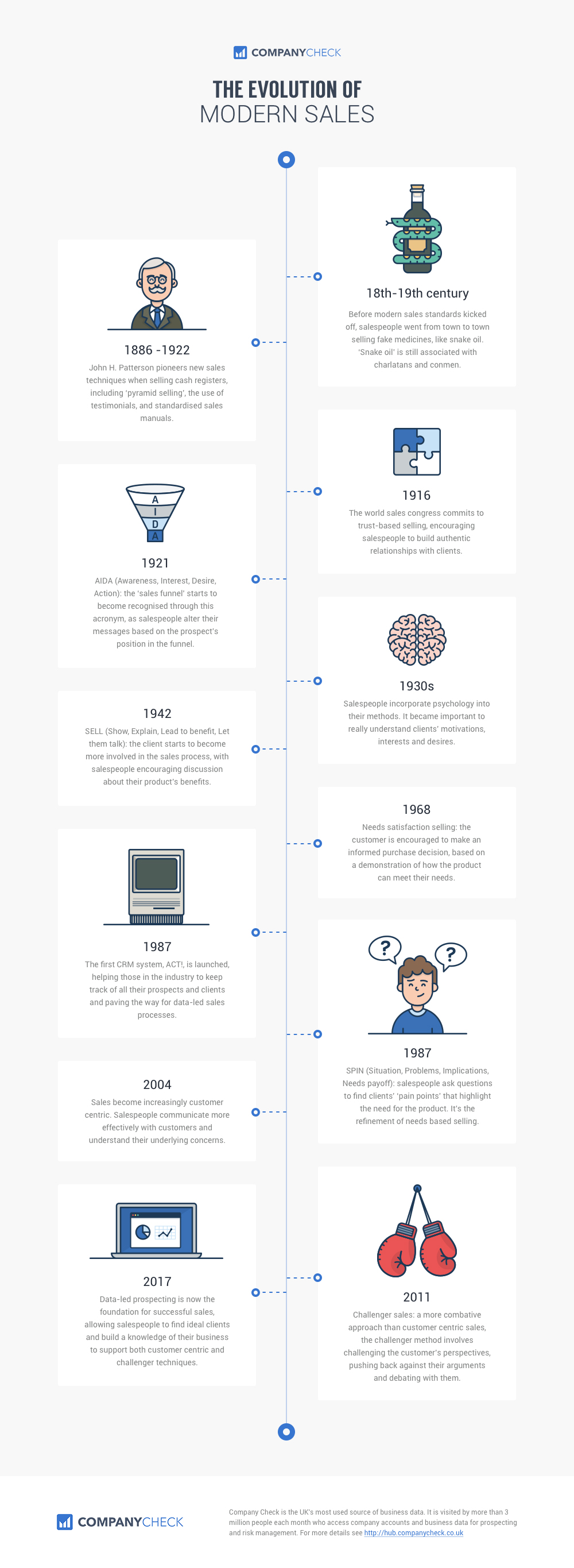Have you ever wondered why we do sales the way that we do? Our 21st century sales techniques weren’t just made up out of nowhere, they’re the evolution of centuries of humans trying to convince other humans to buy what they’re selling.
You’d be reading forever if we went back to the dawn of civilisation, so instead we chose to start our story at the beginning of modern sales, back in the 18th century when unscrupulous salesmen used any and all techniques they could come up with to sell useless products to hapless civilians…

18th-19th century: Those unscrupulous people I mentioned above were known as snake-oil salesmen, thanks to the so-called ‘snake oil’ they sold to people on the pretense that it could cure a variety of afflictions. In reality, there was rarely anything other than regular oil and herbs in their concoctions. The term came to be used to refer to anyone selling fake medicines and harks back to a time where sales were less regulated and information was not as widely available to the general public as it is now.
1886-1922: Modern sales as we know it started at the turn of the 20th century with the legendary John H. Patterson. He pioneered several new sales techniques when selling cash registers and is known particularly for developing the art of getting satisfied customers to do the legwork of the sales, using testimonials in advertising for the first time. He’s also accredited with being the first person to use standardised sales manuals for training, so that everyone in his company would be selling in the same way.
1916: Following on from dubious sales techniques in the last 200 years and the great strides made by John H. Patterson, the World Sales Congress committed to a more trustworthy sales model, calling salespeople to build relationships of trust with clients and to stop lying to sell them products that didn’t really do anything. This ethos is still strong today.
1921: An American sales visionary, Elias St. Elmo Lewis, is credited with the development of AIDA (awareness, interest, desire and action) – a model that describes what we would now think of as the ‘customer journey’ or ‘sales funnel.’ Over the decades since the 1920s it has continued to be important to recognise which stage a customer is at and to adjust your sales message accordingly.
1930s: As the science of psychology continued to develop off the back of revolutionaries like Sigmund Freud and Carl Jung, the prominent ideas of the time began to trickle into sales. It’s still important to have some understanding of consumer psychology today, though we’d be less inclined to try different pitches based on the shape of customers’ heads, as Ford were renowned for doing in this period.
1942: The SELL (show, explain, lead to benefit, let them talk) methodology was developed to give more structure to sales pitches. The pitch became less of a lecture and more of a conversation as salespeople saw the value of allowing customers to interact with them about the product. This helped the salesperson to understand the customer’s needs better and helped the customer to feel more invested in the process.
1968: In the second half of the 20th century, sales techniques developed into ‘needs satisfaction’ methods. The ideas behind SELL evolved to the point where the customer would be encouraged to make an informed sales decision themselves based on a demonstration by the salesperson of how the product meets their specific needs. The power, in some sense, was shifting to consumers, but there was still a lot of room for skilled salespeople to excel.
1987: We took another step towards the sales methodologies of today with the first CRM (customer relationship management) system, ACT! For the first time, salespeople were able to keep track of all of the sales interactions happening across their company, which helped the sales process to become smoother and more efficient.
Around the same time, another acronym popped into existence: SPIN (situation, problems, implications, needs payoff). 45 years after the appearance of SELL, SPIN made the sales process even more customer focused, as salespeople learned to discuss customers’ specific ‘pain points’ that would highlight their need for the product. This would involve the salesperson talking the customer through their problems, with the aim of the customer desiring the product seemingly of their own volition.
2004: In the early stages of the 21st century, customer centric sales was dominant. Following on from all of the lessons of the 20th century, salespeople made every effort to put customer needs first, doing everything they could to help customers to see how their product could help.
2011: The customer centric model was challenged a few years ago by the emergence of Challenger sales. This new strategy was more combative, with the salesperson using their own knowledge of the customer’s needs to challenge their perspectives. They would push back against customer arguments and debate with them, demonstrating with their in-depth knowledge why the customer needs the product.
2017: All of this leads us to today. Customer centric sales certainly aren’t dead, but the Challenger method has shown us that it’s not the only way to go. Whichever method you prefer, the availability of data in the present day means that salespeople can research their customers better than ever before, finding the perfect prospects and honing their sales messages meticulously.
Whatever new methods appear in the next few years, you can be sure that they will be grounded in data and heavily influenced by all the ideas that have shaped sales since the start of the 20th century.



